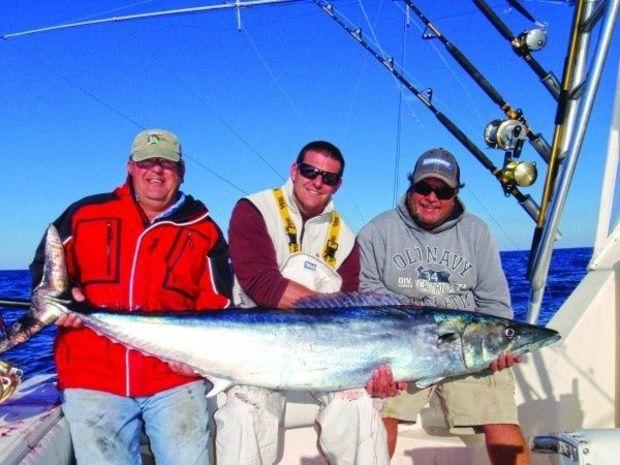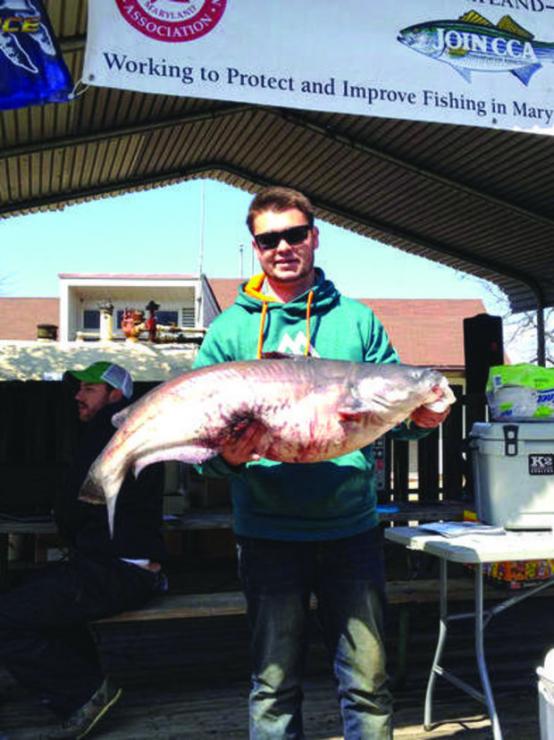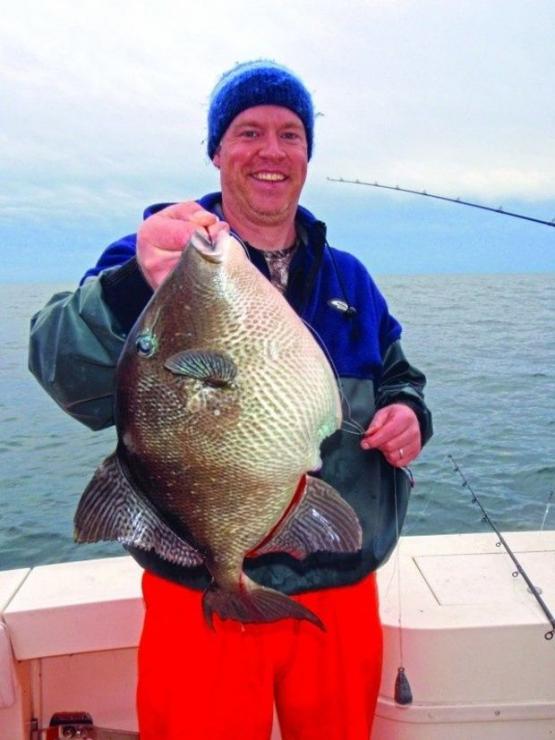Virginia’s Tagging Program Celebrates 20th Anniversary
The “Top Taggers” in Virginia’s volunteer angling program were honored this winter as the cooperative tagging program celebrated 20 years of gaining important data from saltwater anglers who participate in the Virginia Game Fish Tagging Program (VGFTP).
The program recruits and trains volunteer anglers to help scientists and fishermen learn where fish go and how they grow.
“Most anglers don’t know what happens to the fish they release,” says Susanna Musick, coordinator of the program at the Virginia Institute of Marine Science (VIMS). “But by putting numbered tags in the fish they release, they learn about where their fish travel and how much they grow when they are recaptured and reported.”
More than 650 recreational anglers, fishing from boats and piers, have participated as taggers in the program since it started, making the VGFTP one of the most successful volunteer tagging programs in the United States. The event in February was held at Bass Pro Shops to celebrate the program’s 20th anniversary and honor the past year’s top taggers. Ed Shepherd of Yorktown received the award for most tagged fish, tagging an astonishing 2866 fish in one year!
The tagging program targets 10 species: black drum, black sea bass, cobia, summer flounder, red drum, sheepshead, spadefish, speckled trout, tautog, and grey triggerfish. Here are some highlights:

250,000: The total number of fishes tagged since 1995.
28,000: The total number of recaptures that have been reported.
2826: Number of “days at large” (length of time between tagging and recapture) of a tautog.
337 miles in 53 days: A flounder tagged at the CBBT on November 18, 2007 was recaptured off Rhode Island on January 10, 2008. A record!
#27792: The tag number of the fish (a cobia) that holds the longest migration of a tagged Bay fish. Originally tagged at the York Spit (August 22, 2000) it was recaptured off Mississippi in the Gulf of Mexico, May 20, 2004.
18,000: the number of red drum tagged in 2012.
74,529: The number of summer flounder tagged in 20 years.
Coordinated cooperatively between the Marine Advisory Program at VIMS and the Saltwater Tournament program at the Virginia Marine Resources Commission, the program is funded in part from recreational fishing license fees through the VMRC Virginia Saltwater Recreational Fishing Development Fund, with additional support from VIMS.
VA’s Saltwater Fishing Tournament Winners
PropTalk contributor Dr. Ken Neill and his crew aboard Neill’s sportfisher
Healthy Grin garnered 14 species awards for 2014. Stan Simmerman caught the state’s largest wahoo in Virginia in 2014. Dr. Hamish Small caught the largest gray triggerfish in the state.
 CCAMD Hosts Inaugural Catfish Tournament
CCAMD Hosts Inaugural Catfish Tournament
Maryland fishery biologists have declared open season on the invasive blue catfish, which seems to be just fine with the more than 60 anglers who participated in the Coastal Conservation Association of Maryland (CCAMD) central region chapter's inaugural "Invasive Blue Catfish Tournament."
All blue catfish over 30 inches were handed over to fish biologists from Maryland's Department of Natural Resources, which partnered with CCAMD, for research purposes. The smaller fish were barbecued as fish tacos to demonstrate to participants that blue cats can be good to eat as well as a quality game fish.
The winner was Dale Coon, whose 31.16-pounder bested the field. The father-son duo of Zeljko and Ivan Koetic captured the first place in the boat division. Marco Maldanado won the shoreline division. Anglers mainly fished the Potomac River. One of the main purposes of the single day-event, based at Smallwood Park in Marbury, MD, was to bring public awareness of the damage blue cats can inflict on native fish species.
FishAmerica Foundation Receives Another Grant
For the second year in a row, the FishAmerica Foundation has been the recipient of a generous donation from the American Snuff Company to help fund the foundation's mission to promote fisheries conservation and habitat restoration.

"We are honored to receive such a significant contribution" says American Sportfishing Association (ASA) president and CEO Mike Nussman, a resident of Edgewater, MD. "To be selected as a recipient two years in a row is a testament to the important work the foundation does to help conserve our nation's fisheries and their habitats."
The FishAmerica Foundation is ASA's research and conservation arm and provides funding to "help empower local communities to invest in improving sportfishing opportunities and habitat conservation through matching funding and volunteer support. Since 1983, the foundation has invested in more than 900 projects to enhance fish populations, restore fisheries habitats, improve water quality, and advance fisheries research to improve sportfishing opportunities and help ensure fishing's future.
by Captain Chris D. Dollar
 250,000: The total number of fishes tagged since 1995.
28,000: The total number of recaptures that have been reported.
2826: Number of “days at large” (length of time between tagging and recapture) of a tautog.
337 miles in 53 days: A flounder tagged at the CBBT on November 18, 2007 was recaptured off Rhode Island on January 10, 2008. A record!
#27792: The tag number of the fish (a cobia) that holds the longest migration of a tagged Bay fish. Originally tagged at the York Spit (August 22, 2000) it was recaptured off Mississippi in the Gulf of Mexico, May 20, 2004.
18,000: the number of red drum tagged in 2012.
74,529: The number of summer flounder tagged in 20 years.
Coordinated cooperatively between the Marine Advisory Program at VIMS and the Saltwater Tournament program at the Virginia Marine Resources Commission, the program is funded in part from recreational fishing license fees through the VMRC Virginia Saltwater Recreational Fishing Development Fund, with additional support from VIMS.
VA’s Saltwater Fishing Tournament Winners
PropTalk contributor Dr. Ken Neill and his crew aboard Neill’s sportfisher Healthy Grin garnered 14 species awards for 2014. Stan Simmerman caught the state’s largest wahoo in Virginia in 2014. Dr. Hamish Small caught the largest gray triggerfish in the state.
250,000: The total number of fishes tagged since 1995.
28,000: The total number of recaptures that have been reported.
2826: Number of “days at large” (length of time between tagging and recapture) of a tautog.
337 miles in 53 days: A flounder tagged at the CBBT on November 18, 2007 was recaptured off Rhode Island on January 10, 2008. A record!
#27792: The tag number of the fish (a cobia) that holds the longest migration of a tagged Bay fish. Originally tagged at the York Spit (August 22, 2000) it was recaptured off Mississippi in the Gulf of Mexico, May 20, 2004.
18,000: the number of red drum tagged in 2012.
74,529: The number of summer flounder tagged in 20 years.
Coordinated cooperatively between the Marine Advisory Program at VIMS and the Saltwater Tournament program at the Virginia Marine Resources Commission, the program is funded in part from recreational fishing license fees through the VMRC Virginia Saltwater Recreational Fishing Development Fund, with additional support from VIMS.
VA’s Saltwater Fishing Tournament Winners
PropTalk contributor Dr. Ken Neill and his crew aboard Neill’s sportfisher Healthy Grin garnered 14 species awards for 2014. Stan Simmerman caught the state’s largest wahoo in Virginia in 2014. Dr. Hamish Small caught the largest gray triggerfish in the state.
 CCAMD Hosts Inaugural Catfish Tournament
Maryland fishery biologists have declared open season on the invasive blue catfish, which seems to be just fine with the more than 60 anglers who participated in the Coastal Conservation Association of Maryland (CCAMD) central region chapter's inaugural "Invasive Blue Catfish Tournament."
All blue catfish over 30 inches were handed over to fish biologists from Maryland's Department of Natural Resources, which partnered with CCAMD, for research purposes. The smaller fish were barbecued as fish tacos to demonstrate to participants that blue cats can be good to eat as well as a quality game fish.
The winner was Dale Coon, whose 31.16-pounder bested the field. The father-son duo of Zeljko and Ivan Koetic captured the first place in the boat division. Marco Maldanado won the shoreline division. Anglers mainly fished the Potomac River. One of the main purposes of the single day-event, based at Smallwood Park in Marbury, MD, was to bring public awareness of the damage blue cats can inflict on native fish species.
FishAmerica Foundation Receives Another Grant
For the second year in a row, the FishAmerica Foundation has been the recipient of a generous donation from the American Snuff Company to help fund the foundation's mission to promote fisheries conservation and habitat restoration.
CCAMD Hosts Inaugural Catfish Tournament
Maryland fishery biologists have declared open season on the invasive blue catfish, which seems to be just fine with the more than 60 anglers who participated in the Coastal Conservation Association of Maryland (CCAMD) central region chapter's inaugural "Invasive Blue Catfish Tournament."
All blue catfish over 30 inches were handed over to fish biologists from Maryland's Department of Natural Resources, which partnered with CCAMD, for research purposes. The smaller fish were barbecued as fish tacos to demonstrate to participants that blue cats can be good to eat as well as a quality game fish.
The winner was Dale Coon, whose 31.16-pounder bested the field. The father-son duo of Zeljko and Ivan Koetic captured the first place in the boat division. Marco Maldanado won the shoreline division. Anglers mainly fished the Potomac River. One of the main purposes of the single day-event, based at Smallwood Park in Marbury, MD, was to bring public awareness of the damage blue cats can inflict on native fish species.
FishAmerica Foundation Receives Another Grant
For the second year in a row, the FishAmerica Foundation has been the recipient of a generous donation from the American Snuff Company to help fund the foundation's mission to promote fisheries conservation and habitat restoration.
 "We are honored to receive such a significant contribution" says American Sportfishing Association (ASA) president and CEO Mike Nussman, a resident of Edgewater, MD. "To be selected as a recipient two years in a row is a testament to the important work the foundation does to help conserve our nation's fisheries and their habitats."
The FishAmerica Foundation is ASA's research and conservation arm and provides funding to "help empower local communities to invest in improving sportfishing opportunities and habitat conservation through matching funding and volunteer support. Since 1983, the foundation has invested in more than 900 projects to enhance fish populations, restore fisheries habitats, improve water quality, and advance fisheries research to improve sportfishing opportunities and help ensure fishing's future.
by Captain Chris D. Dollar
"We are honored to receive such a significant contribution" says American Sportfishing Association (ASA) president and CEO Mike Nussman, a resident of Edgewater, MD. "To be selected as a recipient two years in a row is a testament to the important work the foundation does to help conserve our nation's fisheries and their habitats."
The FishAmerica Foundation is ASA's research and conservation arm and provides funding to "help empower local communities to invest in improving sportfishing opportunities and habitat conservation through matching funding and volunteer support. Since 1983, the foundation has invested in more than 900 projects to enhance fish populations, restore fisheries habitats, improve water quality, and advance fisheries research to improve sportfishing opportunities and help ensure fishing's future.
by Captain Chris D. Dollar